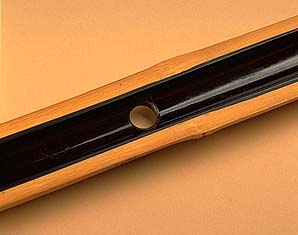|
|
|
|
If bamboo is considered to be the soul
of the shakuhachi, the bore of the instrument is clearly its heart.
Subtle variations in bore diameter -- a few hundredths of a millimeter
-- anywhere along the length of the flute often produces dramatic
differences in resonance, intonation and timbre. Bore design far
outweighs any other factor in determining the subtle qualities
of sound which characterize each individual instrument.

Cross Section of the Precision Cast Bore
Tai Hei Shakuhachi has developed a unique and innovative process which enables the maker to shape and size the bore to within extremely fine tolerances. Unlike traditional methods of fabrication, the precision casting technique allows for exact reproduction of bore profiles in every instrument made. After casting, each flute is evaluated and adjusted to produce an optimum balance in all of the notes played. This fine tuning process is a delicate art; one that is very critical in compensating for the fact that no two pieces of bamboo (hence no two shakuhachi) are exactly alike. Fine tuning the bore coupled with precision casting accounts for the superior tonal quality, responsiveness and accuracy of tuning characteristic of Tai Hei Shakuhachi. These instruments are played and recommended by some of the world's most respected teachers and musicians.
Bore designs used in Tai Hei Shakuhachi are derived from an analysis of some of the finest historical and modern instruments available in Japan. Interiors of all the flutes are cast to a mirror finish with a specially formulated blend of epoxy resins. Precision cast bores are highly compatible with bamboo. They are durable, very stable and provide a dense resonating surface that will neither shrink nor separate from the bamboo. The epoxy bore exhibits a superior bonding property which minimizes swelling of the bamboo and cracking due to changes in climactic conditions.